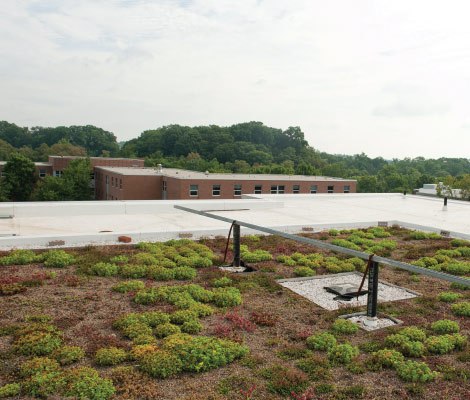Want to see UMBC’s sustainable future? Just make your way to the roof of Patapsco Hall – where efforts make UMBC greener are intersecting with pedagogy and academic research.
A recent $16.5 million renovation and addition to the residence hall – designed by Newman Architects and built by KBE Building Corporation – recently received a Leadership in Energy and Environmental Design (LEED) Gold certification. It is the first building on campus to receive this designation.
One of the key features in obtaining this certification is Patapsco Hall’s “green roof.” These green roofs are important elements of sustainable design since they help reduce storm water runoff that is key cause of pollution in the Chesapeake Bay and in other local streams and rivers. Rooftop vegetation helps to insulate the building, reducing energy consumption. Vegetated surfaces also improve air quality and capture the greenhouse gas carbon dioxide.
Patapsco Hall’s green roof is also the platform for a research project focusing on sustainable design and construction. The green roof is paired with an identically-sized control area. Each area features dedicated drainage systems and rainwater quantity and quality measurement devices.
Andrew J. Miller, a professor in UMBC’s geography and environmental systems department, says that the data generated by the system will document storm water retention and monitor runoff from both portions of the roof, allowing comparisons in terms of quantity and quality. Storm water retention totals and storm hydrographs are displayed in real-time in the building’s lobby – and Miller plans incorporate the data into his classes.
When I teach hydrology, I always have the students access real data from local USGS stream gages as well as rainfall data from nearby sources,” he observes. “One of the best ways to assess [green roofs’] effectiveness is to have monitoring sites side by side on the same roof, comparing how much water runs off the traditional roof compared with the green roof. Having such a monitoring site right here on campus collecting information in real time presents a great educational opportunity.”
The LEED rating system was developed by the U.S. Green Building Council (USGBC) in 2000 and provides verification that a building was designed and built using aspects of efficient environmental health conservation strategies. Certifications of Silver, Gold, and Platinum recognizes varying levels of design and performance in areas including sustainable site development, water savings, energy efficiency, materials selection, and indoor environmental quality.
The push for new LEED designated sites at UMBC is not limited to Patapsco. The university’s Performing Arts and Humanities Building has been awarded a LEED Silver designation. Its sustainable features include a rainwater harvesting system (for on-site irrigation), use of pervious concrete sidewalks and a white roof which will reduce the building’s urban heat island effect.
– Chelsea Haddaway
Tags: Fall 2013

